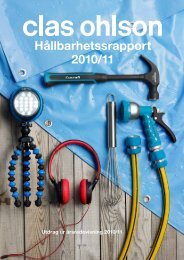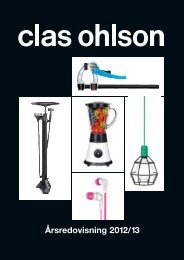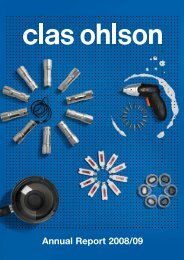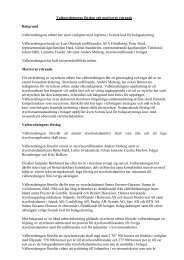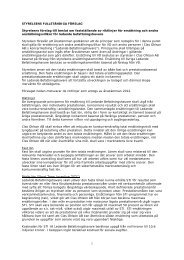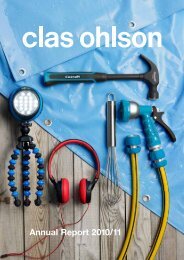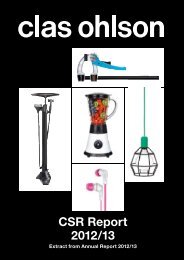Annual Report 2012/13 - Clas Ohlson
Annual Report 2012/13 - Clas Ohlson
Annual Report 2012/13 - Clas Ohlson
Create successful ePaper yourself
Turn your PDF publications into a flip-book with our unique Google optimized e-Paper software.
Preventive and training measures<br />
Initially, some manufacturers may have very little knowledge<br />
of our demands and regulations or how they can achieve<br />
compliance. During the audits, our auditors inform the manufacturers<br />
of our requirements and the areas that must be<br />
improved. We have produced training material in health and<br />
safety, Human Resources and the environment to support<br />
manufacturers’ efforts to improve their operations. During<br />
the year, we conducted 71 training programmes at manufacturing<br />
facilities in Asia.<br />
Although <strong>Clas</strong> <strong>Ohlson</strong> is often a small customer for our<br />
suppliers, most of them react positively to being audited<br />
and are willing to work toward improving any deficiencies.<br />
However, we do encounter manufacturers that for various<br />
reasons are not prepared to permit access for audits or are<br />
not interested in working within the given timeframes for<br />
achieving the improvements that are required. If we cannot<br />
convince them to change their position, despite attempts<br />
and discussions, we terminate our partnership with them.<br />
Recurring audits<br />
We conduct recurring audits of our active manufacturers,<br />
and these are revised at least every second year. During<br />
the financial year, we performed 409 audits, both initial and<br />
recurring. Our own auditors conducted 380 audits, and 29<br />
external audits were performed by third-party audit firms<br />
specialised in social responsibility and human rights.<br />
An audit normally takes 1-2 days, depending on the size<br />
of the factory and number of employees. The auditors inspect<br />
the factory’s premises, interview employees and examine<br />
documents. The audit is documented in a report. If we<br />
identify any non-compliance with our Code, an action plan<br />
is prepared with information about the actions that must be<br />
taken by the factory within a given timeframe (read more<br />
under “The CSR audit process” on page 35).<br />
Assessment of the CSR level<br />
Our manufacturers’ CSR levels are assessed according to a<br />
range of colours:<br />
Green Meets the requirements of our Code Conduct<br />
Yellow Identified non-compliance with the Code<br />
Orange Identified high-risk non-compliance with the Code<br />
Red Identified zero-tolerance non-compliance with<br />
the Code<br />
Non-compliance and improvements<br />
In our audits, most non-compliance is identified in the areas<br />
of health and safety, such as deficiencies in the use of protective<br />
equipment, evacuation and fire protection, and in<br />
wages and working hours, such as excessive overtime or<br />
denial of social security rights. During the year, most improvements<br />
were noted in the health and safety area. General<br />
improvements in relation to wages and working hours take<br />
longer to achieve. These issues are complex and require a<br />
long-term process, in which both the purchasers and manufacturers<br />
of goods in Asia, in consultation with authorities<br />
and NGOs, must work together to find sustainable solutions.<br />
Since many manufacturers have “yellow” in terms<br />
of their CSR level (with some non-compliance), we plan to<br />
focus on raising the manufacturer’s level toward green (no<br />
non-compliance) to enable goal-setting and to strengthen<br />
cooperation with strategically important manufacturers that<br />
can demonstrate a positive CSR result.<br />
Cotech laser distance meter. Quick, accurate and easy-to-use<br />
distance meter. Accurate readings even on small areas and long<br />
distances (up to 40m).<br />
40-8786<br />
GRI (Global <strong>Report</strong>ing Initiative)<br />
In 2009, <strong>Clas</strong> <strong>Ohlson</strong> introduced GRI – the global standard<br />
for sustainability reporting – to benchmark our progress with<br />
sustainability. The introduction of GRI has also generated<br />
value for <strong>Clas</strong> <strong>Ohlson</strong> by providing a framework with well-defined<br />
performance indicators that can be used to set targets<br />
and monitor results in selected areas.<br />
<strong>Report</strong>ing non-compliance and<br />
implemented measures<br />
Selected performance indicators in the area of human rights<br />
are presented in tables on page 34.<br />
HR4 Non-discrimination<br />
Audits during the year identified zero cases of discrimination.<br />
In past years, identified cases of discrimination have<br />
included the absence of an anti-discrimination policy or<br />
specifying the desired age and/or gender of candidates in job<br />
advertisements. In these cases, <strong>Clas</strong> <strong>Ohlson</strong> has demanded<br />
the introduction of an anti-discrimination policy and<br />
reformulation of the advertisements.<br />
HR5 Freedom of association and the right<br />
to collective bargaining<br />
We identified 15 cases of restricted freedom of association<br />
and the right to collective bargaining. We have demanded<br />
that these suppliers introduce systems to eliminate this restriction.<br />
In general, freedom of association is a major problem<br />
in Asia and represents a considerable and important<br />
area of development that requires collaboration between manufacturers,<br />
purchasing companies, NGOs and authorities.<br />
Sustainable development Sustainable development 33



